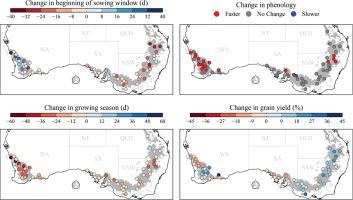Climate Risk Management ( IF 4.4 ) Pub Date : 2021-03-17 , DOI: 10.1016/j.crm.2021.100300 Brian Collins , Karine Chenu

|
With global food demand predicted to grow by 50–80% by 2050, timely strategies are required to best adapt to the projected changes in agriculture. In this study, we illustrated how adaptation strategies not requiring additional inputs (sowing date and genotype choice) could be used to minimise the impact of projected stresses and raise wheat productivity in Australia. Yield and abiotic stresses impacting productivity of wheat crops were quantified in silico for the 1990s (1976–2005) and the 2050s (2036–2065) across the Australian wheatbelt using a modified version of the Agricultural Production Systems sIMulator (APSIM) and 33 Global Circulation Models (GCMs) under the Representative Concentration Pathways (RCP) 8.5. Two adaptation strategies were assessed: adaptation of sowing dates and/or adaptation of cultivars of contrasting phenology (i.e. fast-spring, mid-spring, slow-spring and fast-winter cultivars). For a given cultivar, optimum sowing windows associated with highest long-term yield were projected to shift to earlier dates by 2050 at most locations, with an average shift of 9.6 days for a mid-spring cultivar. Sowing early maturing cultivars enabled further increase in projected yield in major parts of the wheatbelt. In the tested conditions, sowing and cultivar adaptation allowed simulated crops to minimise the impact of abiotic stresses while limiting the shortening of the grain filling period due to global warming. Thanks to CO2 fertilisation and proper adaptation, the frequency of severe frost, heat and drought stress was reduced in all regions, except in the West where severe drought was projected to occur more frequently in the 2050s. This allowed a national yield increase of 4.6% with reduced risk of crop failure at most locations. While the study focused on stress avoidance through adaptations (sowing dates and choice of cultivar phenology), breeding for enhanced drought and heat tolerance appeared promising avenues to further improve wheat productivity.
中文翻译:

通过适应未来的播种日期和基因型物候来提高澳大利亚小麦的生产力
到2050年,全球粮食需求预计将增长50-80%,因此需要及时采取战略,以最好地适应农业的预期变化。在这项研究中,我们说明了如何使用不需要额外投入(播种日期和基因型选择)的适应策略来最大程度地减少预计压力的影响并提高澳大利亚的小麦生产力。在计算机上量化了影响小麦作物生产力的单产和非生物胁迫在1990年(1976-2005年)和2050年代(2036-2065年)的整个澳大利亚小麦带上,使用农业生产系统模拟程序(APSIM)的改进版本和代表浓度路径(RCP)8.5下的33种全球流通模式(GCM) 。评估了两种适应策略:播期的适应和/或物候相反的品种的适应(即快春,中春,慢春和快冬品种)。对于给定的品种,与最高长期产量相关的最佳播种期预计在大多数地点将在2050年之前移到较早的日期,中春品种平均移到9.6天。播种早熟品种可以进一步提高小麦带主要部分的预计单产。在测试条件下 播种和品种适应使模拟作物能够最大程度地减少非生物胁迫的影响,同时限制由于全球变暖而导致的籽粒充实期的缩短。多亏了CO2施肥和适当的适应措施,除西部地区预计在2050年代发生严重干旱的地区之外,所有地区的严重霜冻,高温和干旱胁迫的发生率均降低。这使全国单产提高了4.6%,同时大多数地区的农作物歉收风险降低。虽然研究的重点是通过适应措施(播种日期和品种物候选择)来避免胁迫,但为增强干旱和耐热性而进行的育种似乎是进一步提高小麦生产力的有前途的途径。



























 京公网安备 11010802027423号
京公网安备 11010802027423号